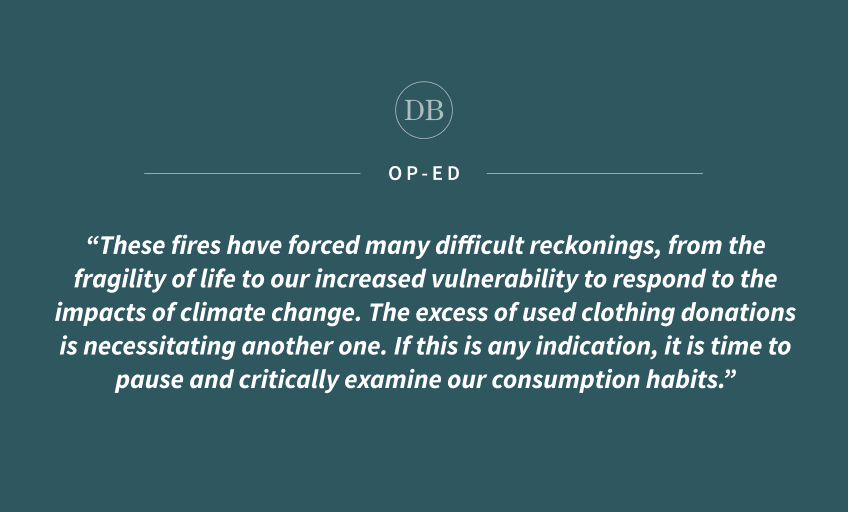Op-ed: Consumers must examine detrimental effects of donating used clothes on environment

By Ella Johnson
Jan. 26, 2025 4:53 p.m.
This post was updated Jan. 26 at 8:01 p.m.
As Los Angeles grapples with the aftermath of the horrific wildfires that have now been burning for weeks, a secondary crisis has emerged: mountains and mountains of secondhand clothes.
Trash bags full of clothing donations are piled multiple-feet high in parking lots across the city, waiting to be sorted. Overburdened donation centers don’t know what to do with the sheer amount of clothes, much of which is destined for landfills where they will infiltrate our waste streams and further pollute the environment.
As relief efforts mobilized, donation centers across the city announced that they were no longer accepting used clothing donations. While well intended, people jumped at the opportunity to clean out their closets in the name of giving.
This has resulted in an influx of inadequate and often unwearable clothing that is infiltrating aid and relief centers. It has exposed a profound problem – most people have so much clothing that they don’t want and don’t know what to do with.
Unwanted items are overwhelming donation centers that do not have the capacity to deal with them, the technology to sort them or even the networks to distribute them to people in need.
Organizations, brands and influencers in other states are running drives to ship boxes of used clothes to centers in LA, without a final destination in mind. We have become a dumping ground for what is already one of the fastest-growing materials in our waste streams: textiles.
This problem is not new, but it is clear – we don’t know what to do with our unwanted clothes. In December 2024, the Government Accountability Office released a report estimating a 50% increase in textile waste between 2000 and 2018.
Most commonly, clothes – which often decompose slowly – are either landfilled where they leach chemicals into our air, soil and water, or incinerated. While donation has been regarded as a better option, only 20% of donated clothing is resold domestically.
If not, they are often exported to other countries. Ghana, for instance, imports about 15 million used garments from the Global North each week and distributes them at secondhand clothing markets like the Kantamanto market.
Currently, Kantamanto itself is undergoing a rebuild after a fire decimated the market Jan. 2, illustrating the instability of this waste management system.
The sheer volume of secondhand clothing overwhelms processing centers and has discouraged domestic garment manufacturing to the point where countries like Uganda have attempted to ban the importation of used clothes. As a result, consumers are rarely forced to reckon with the reality of our trash.
Yet, as this problem escalates, the reality of our overproduction and overconsumption is knocking on California’s door.
The fires in LA have become an opportunity for people to get rid of their clothes and clear their consciences. But in reality, there is not enough storage capacity for the clothes that are being donated.
People who have lost everything, including their homes, and are likely living in evacuation centers and hotels, can often can only keep a few supplies, let alone fill closets they don’t have.
Despite this altruistic intent, some donations are beginning to cause more harm than good.
This profound moment highlights the need for adequate waste management infrastructure, illustrating the importance of legislation like California’s SB 707, which implemented a textile-recycling stewardship program.
Brands like Trashie, which created the Take Back Bag as a way for consumers to responsibly recycle their clothing through a rewards system, are stepping up.
Over the next month, they’ll be organizing collections and pickups from organizations and centers on the ground that want to remove large amounts of excess clothing donations. Using their resources, these donations will be consolidated, sorted and managed responsibly for community needs in the coming months.
If you are aware of an organization or donation center that is overcapacity and needs access to these services, they can fill out this form to be looped into the initiative.
These fires have forced many difficult reckonings, from the fragility of life to our increased vulnerability when responding to the impacts of climate change.
The excess of used clothing donations is necessitating another one. If this is any indication, it is time to pause and critically examine our consumption habits.
For all of us desperately looking for some way to contribute and help, one thing you can actually do is not donate your clothes and continue engaging with the community as the true months of recovery are yet to come.
Ella Johnson is a fourth-year public affairs student.





